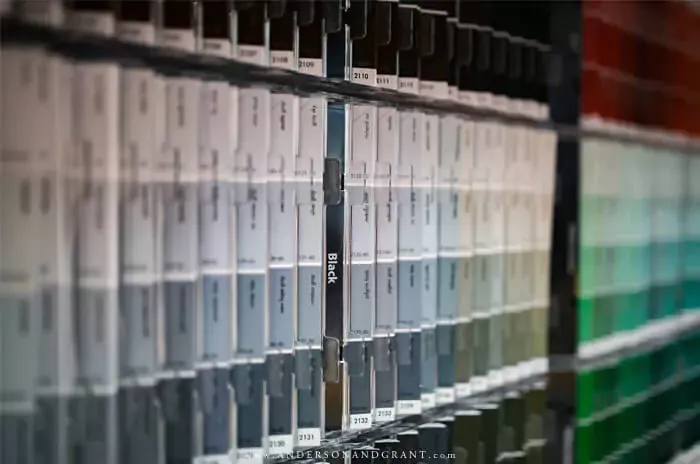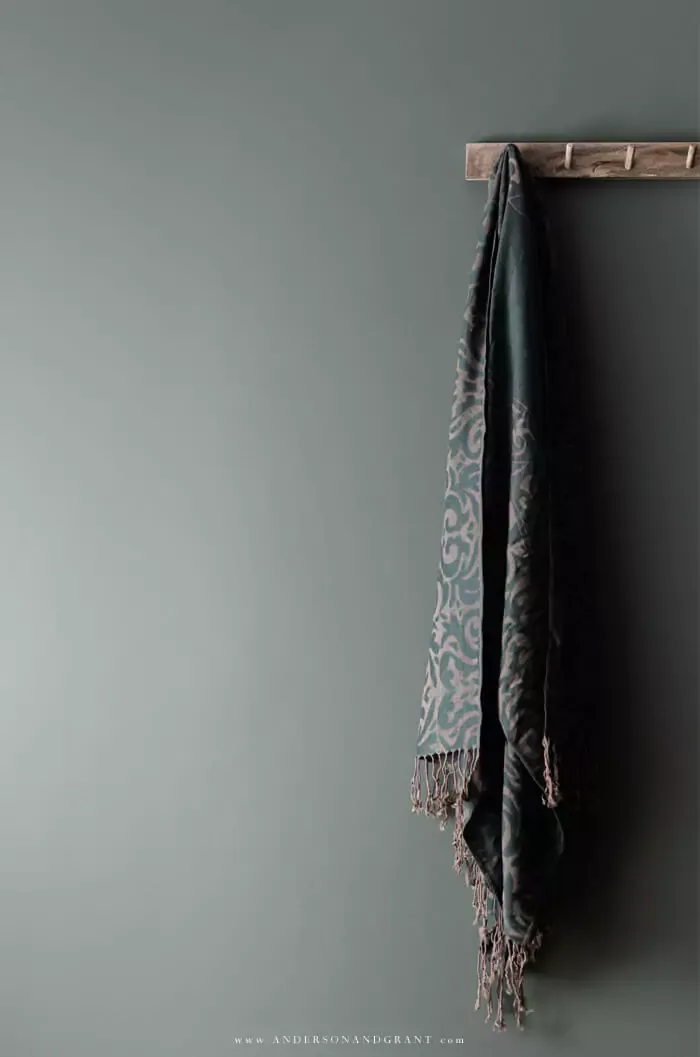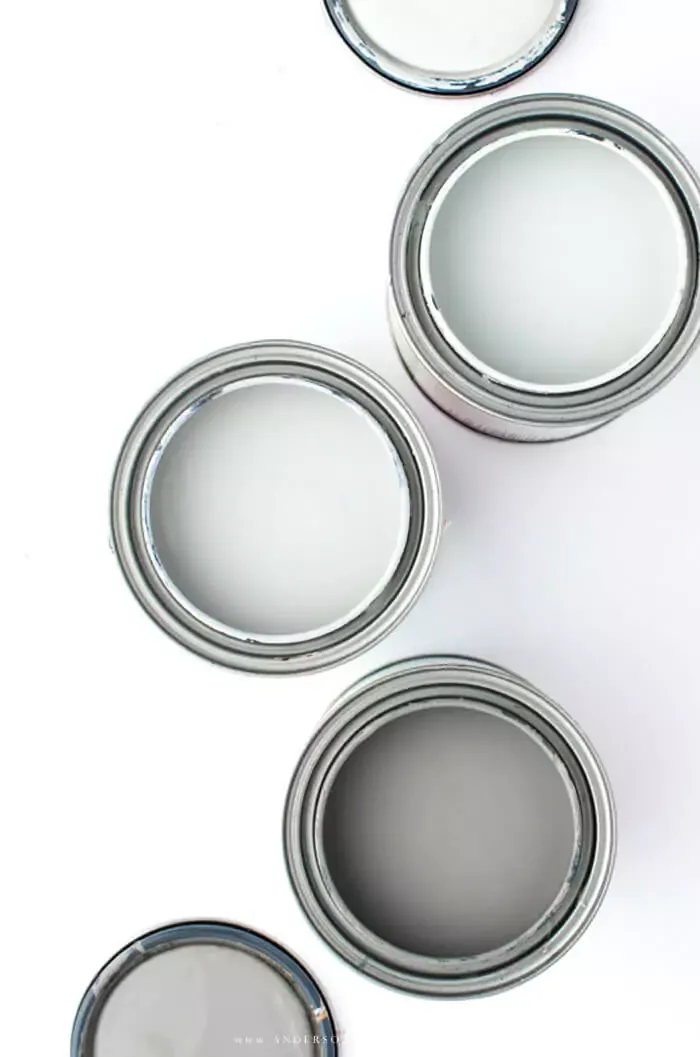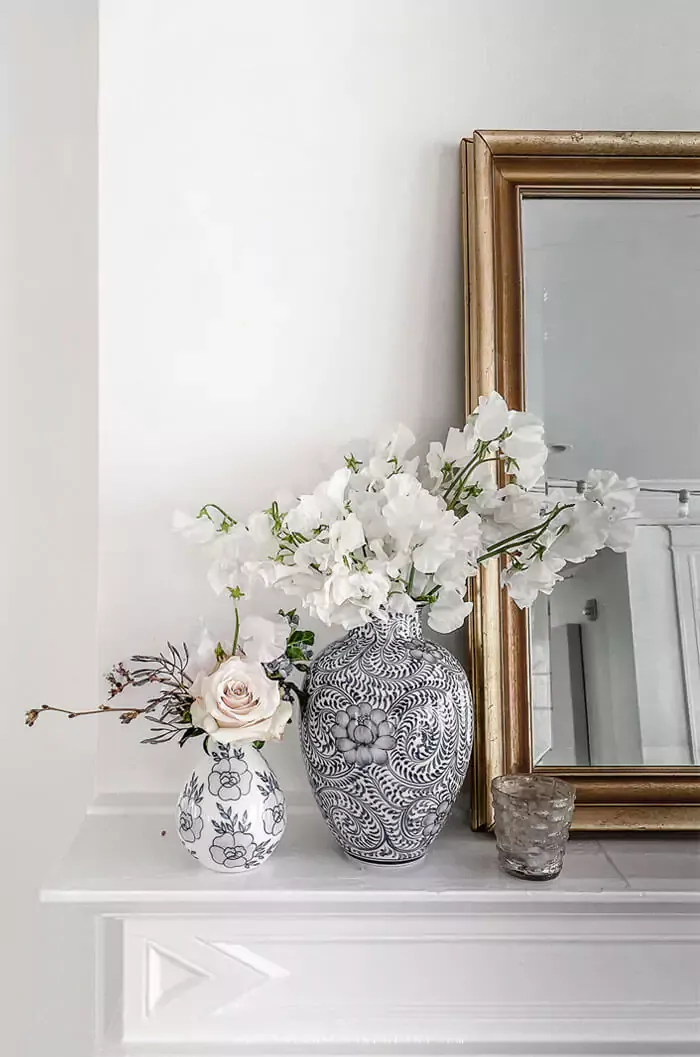Everything you need to know about choosing the right paint finish for your home: Learn the pros and cons of each five sheens, what is the best choice for each room in your home, and more.
DESIGN + STYLE | Updated March 27, 2023

Although selecting an updated paint color is exciting and gets all the glory in the design process, it is choosing the right paint sheen that is vital to achieving a smooth, long lasting finish.
While the color is what we see, the finish of the paint determines how it appears on our wall and how it will withstand the wear and tear of daily living.
Oftentimes, the employee at the paint store will be able to correctly guide you to the type of paint for the project you are working on. But it is nice to walk into the store with the knowledge of what is best for your own home and not rely on the opinions of other people.
So here is what you need to know before you begin your next painting project...

YOUR COMPLETE GUIDE TO CHOOSING THE RIGHT PAINT SHEEN
What is Paint Sheen?
Paint sheen (or paint finish) refers to how shiny the paint is and how much light is reflected off of its surface.
Paints with sheen reflect light.
Paints without sheen absorb light.
On the technical side, paint sheen is determined by the amount of resin mixed in with the pigment (or color) of paint. The resin causes light to bounce off of the paint's surface and appear shiny.
Paints with glossier (shiny) finish have a higher level of resin and lower level of pigmentation.
Paints with a flatter (chalky) finish have a lower level of resin and higher level of pigmentation.

What Does Paint Sheen Do?
A paint's finish is just as important as the color, but it is rarely given much thought. It has a major effect on how easy the walls are to clean, the color you perceive in the room, and the character that it lends.
DURABILITY
The finish level of your paint impacts its durability. The more glossy sheens are easier to wash and longer lasting than more matte finishes.
The higher the sheen, the higher the shine....and the higher the shine, the more durable the paint will be.
The flatter the finish, the more porous and challenging it will be to clean.
Although they are more durable, high sheen paints normally require an entire expanse of wall be repainted rather than touched up, whereas low sheen paints are easy to touch up when necessary.
PERCEPTION OF COLOR
The way a color appears can be completely different based on the paint's finish. Higher gloss paints are very reflective which can make colors appear darker than matte or eggshell sheens.
The higher the sheen, the darker and more intense the color.
COVERAGE ON IMPERFECT WALLS
Because of the shine they reflect, high sheen paints highlight imperfections, dings, and scratches in the wall. If using these sheens, it is important to do a lot of prep work to get a smooth surface for painting.
Low sheen paints, however, are great at hiding imperfections and are the ideal choice in older homes where walls are likely less than perfect.

Things to Consider
Choosing the right finish for your paint depends on the condition of what you are painting, how the space is used, and the way you want it to look.
Specifics about what works best where appear further down in the post.
THE CONDITION OF WHAT YOU ARE PAINTING: If your walls have imperfections due to age or the type of material, shiny paint will draw attention to them.
THE COLOR OF YOUR PAINT: Darker colors naturally have a higher sheen. If going for a color in a rich palette, consider using a lower level sheen, especially if you don't want an overly shiny look or if your wall is not smooth..
BUDGET: The more sheen a paint has, the higher the price will likely be. This is because of the additional resin used when the paint is mixed.
HOW THE ROOM IS USED: If the room is used by children and pets or sees a lot of traffic, opt for a higher sheen paint because as it will be easier to clean. For rooms with a lot of humidity and moisture, you'll also want a shinier paint because it is more durable.
LIGHTING IN THE ROOM: Natural light reflects differently than artificial light on the paint finish. If your room is well-lit with lots of natural light, choose a finish with a more matte sheen.
WHAT YOU ARE PAINTING: Different surfaces require different sheens of paint. Are you painting walls, the ceiling, trim, or cabinets?

5 Types of Paint Finishes
Latex and oil-based paint comes in five different paint sheens: Flat, Eggshell, Satin, Semi-gloss, and Gloss. The color you want should be available in any of these types of paint.
Paint finishes range from a low sheen (flat and eggshell) which absorbs light to a high sheen (semi-gloss and gloss) which is highly reflective. Satin finish falls right in between with the best of both categories.
Each finish has its own set of pros and cons. The difference between them lies in their shine, which affects how easy it is to clean the painted surface and how well the paint will mask imperfections. You must decide what is best for your family and the look you are trying to achieve.
The sheen options sometimes vary by the manufacturer with some having additional finishes or alternative names.
If a brand's sheen does not work for you aesthetically for a project, consider mixing two different sheens together to get a custom, in-between finish.
Here are some specifics about each of the traditional paint finishes:
FLAT (OR MATTE) FINISH
Flat paint is considered "the concealer of paint finishes." Since it has the most pigment, it gives the best for coverage, but is the least durable type of paint. It can be incredibly difficult to clean dirt and fingerprints from a flat finished surface, so don't use it in high traffic areas that get dirty quickly. Because a matte finish doesn't have a sheen, it is great at hiding surface imperfections. Flat paint is best used on ceilings.
LOOKS + FEELS: Intimate, warm, and sophisticated; Colors appear rich and deep
BEST USED FOR: Ceilings, old or imperfect walls, plaster walls with bumps and waves, seldom used rooms, low traffic areas, rooms with lots of natural light, formal dining and sitting spaces
DON'T USE: In rooms with moisture and humidity like kitchens, bathrooms, and laundry rooms; On trim or doors; If you have small children because cleanup is difficult
PROS: Easy to touch up; Soaks up light hiding scratches, flaws, and imperfections creating a smooth, uniform surface; Requires fewer coats to cover imperfections; Great depth of color; Forgiving finish for a beginner painter.
CONS: Difficult to keep clean and rubbing can result in burnishing or the paint coming off with the grime; Reacts poorly to moisture; Chips and scratches easily; Porous texture traps dirt
Flat paint finishes are trending right now. If this is a look that you'd like to use on your walls even though it is hard to clean, be sure to purchase a high quality paint and use a primer plus at least two coats of paint.....And be prepared for regular touch-ups.
EGGSHELL FINISH
For a color that is just as rich as flat, but easier to clean, look for an eggshell finish. It is historically the most popular paint sheen because it balances cleanability, has a low luster sheen, and easy application. Eggshell is best suited for bedrooms, living rooms, and dining rooms.
LOOKS + FEELS: Slightly velvety with a soft texture, like the surface of an egg; Has a soft glimmer when light hits it; Calm and serene
BEST USED FOR: Rooms that see a moderate amount of traffic (like adult bedrooms, dining rooms, hallways, and formal entryways) and no-moisture areas
DON'T USE: In rooms with moisture or on trim and doors
PROS: Durable; Easy to clean with a damp cloth; Resists stains, scuffs, and fingerprints better than a flat finish
CONS: Shows more imperfections than flat; Paint finish can't be scrubbed
SATIN FINISH
Satin is the best all-around finish for durablity and shine. It is the Goldilocks of paint finishes because it has more sheen than eggshell or flat, but isn't shiny like semi-gloss or gloss. The painted surface is easy to wipe down and does a terrific job of resisting moisture. Satin paint is great for kitchens, bathrooms, laundry rooms, hallways, and other high traffic areas.
LOOKS + FEELS: Pearl-like appearance with a soft, romantic shine.
BEST USED FOR: Moderate to high traffic areas, window sills, trim, cabinets, interior doors, rooms that don't get a lot of natural light, areas that have exposure to moisture
DON'T USE: In playrooms because it is a washable, not scrubbable finish
PROS: Hides imperfections like bumpy walls reasonably well; Better able to resist dirt and grime while being easier to clean
CONS: Slightly harder to apply for a beginner painter as it reveals application flaws like roller or brush strokes; Touch ups are tricky down the road; Draws more attention to cracks, holes, and flaws than the lower sheen paints
SEMI-GLOSS FINISH
Semi-gloss is a durable finish that is slightly less shiny than a gloss paint finish. It is extremely durable, making it easy to wipe away food spatters and fingerprints. Because of the shine, however, this paint will highlight anything that might be wrong with the surface you are painting. Semi-gloss paint is most commonly used on trim and molding, kitchen cabinets, and doors.
LOOKS + FEELS: Sleek, radiant, and clean
BEST USED FOR: Walls of rooms that see moderate to high traffic, trim and millwork, interior doors, high moisture or greasy areas, wainscoting and paneling, dark rooms without a lot of natural light
DON'T USE: On imperfect walls, repurposed cabinets, or old trim
PROS: Durable, washable and able to withstand multiple cleanings; can be mildew resistant
CONS: Imperfections will be seen easily so walls need to be smooth and free of debris; More difficult to apply for a beginner painter
When painting with a semi-gloss or gloss finish, apply multiple thin coats rather than one thick coat to achieve the smoothest finish.
GLOSS FINISH
For the most part, gloss is considered a specialty finish and is the most reflective and shiny, most durable and highlights imperfections the most. The benefit of using gloss paint is that it doesn't hold onto grease or oil, making it extremely wipe-able. Gloss paint is most commonly applied to furniture giving it a lacquered look or used along with various sheens of the same color to paint subtle accents on a wall.
LOOKS + FEELS: Brilliant, glass-like finish; Glamourous and statement making, but tricky to pull off; Energetic
BEST USED FOR: Molding and millwork, doors, cabinets, furniture, as an accent on walls or ceiling
DON'T USE: On interior walls, on natural wood when you want to hide grain marks, anything with imperfections or flaws
PROS: Hard wearing; Easy to clean and resists dirt, stains and mildew
CONS: Shows surface imperfections so preparation is key; Best left to professionals; Requires more coats than less glossy finishes.

Best Paint Choices Organized By Room
For each space, make your choice depending on the traffic the room sees and the level of durability needed. Although you can use a single sheen throughout a room, you will likely find you need multiple sheens of paint for the same room. For example, you may choose flat for the ceiling, satin for the walls, and semi-gloss for millwork and doors. (Paint finishes are listed in order of best choice first.)
CEILINGS: Flat or Eggshell Finish (Ceilings are barely ever touched and won't need deep cleaning, so flat is an affordable paint option.)
WALLS: Satin, Eggshell, or Flat Finish
TRIM: Semi-Gloss, Gloss, or Satin Finish
DOORS: Semi-Gloss or Gloss Finish
BASEMENT: Satin or Semi-Gloss Finish
BATHROOM: Semi-Gloss or Satin Finish (Semi-gloss is recommended because of its resistance to moisture and humidity. You can wipe up splashes and condensation without leaving spots on the wall. Look for paint formulated for mildew resistance.)
BEDROOM (MASTER OR GUEST): Eggshell, Satin, or Flat Finish
BEDROOM (CHILDREN'S): Satin or Semi-Gloss Finish so that bumps, dirt, and fingerprints can be cleaned easily with damp rag.
DINING ROOM: Eggshell, Satin, or Flat Finish
ENTRYWAY: Satin (if your front door is seldom used and only by visitors), Semi-Gloss (if this is a high traffic area used by everyone so that handprints and marks from bags and backpacks will wipe away easily)
FAMILY ROOM: Satin
HALLWAY: Satin or Eggshell Finish (Satin is ideal, but if you don't have kids or pets you may be able to use eggshell.)
HOME OFFICE: Eggshell, Satin, or Flat Finish
KITCHEN: Semi-Gloss or Satin Finish ( If stovetop and sink are surrounded by a lot of exposed wall space and minimal backsplash, choose a semi-gloss finish because it is easy to clean up from the daily spills, grease stains, and moisture that kitchens see.)
LAUNDRY ROOM: Semi-gloss or Satin Finish (Semi-gloss makes this often windowless space reflect enough light to make the room feel less cave-like.)
LIVING ROOM: Eggshell, Satin or Flat Finish
MUDROOM: Semi-gloss or Satin Finish
PLAYROOM: Semi-Gloss or Satin Finish
STAIRWAY: Eggshell or Satin Finish
INTERIOR FURNITURE: Satin, Semi-Gloss, or Gloss (Use gloss only for statement, high impact furniture.)
In the end, the type of paint you choose is really a matter of personal preference. These are just some basic guidelines to help you make the best decision for your home so that your painting time is well-spent and the finish lasts until you're ready for a change of color.
READ NEXT: Paint Like a Pro With These Must Have Tools

READ NEXT: Paint Like a Pro With These Must Have Tools

